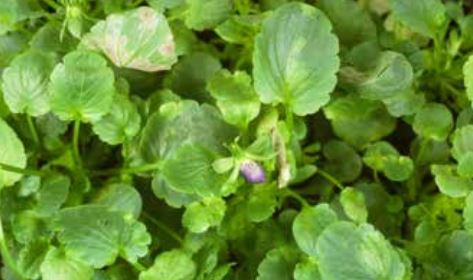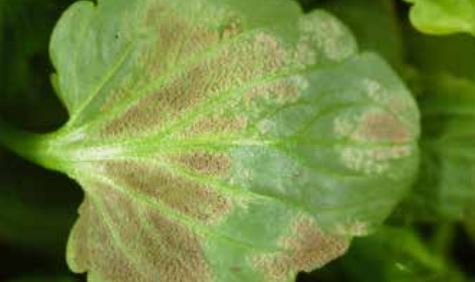Please click here to access the main AHDB website and other sectors.
- Home
- Knowledge library
- Downy mildew in pansy and viola
Downy mildew in pansy and viola
Learning how to recognise downy mildew and understanding its basic biology will help you choose the best control strategies and minimise the risk of crop damage and fungicide resistance.
This information was last updated in 2014.
Go back to the main page: Controlling leaf and root diseases of pansy and viola
Downy mildew caused by Peronospora violae is one of the most common and destructive diseases of pansy and viola.
Like most downy mildew pathogens, P. violae is host-specific and will not cross-infect other bedding plant species.
It usually appears during the spring or autumn when weather conditions favour infection.
Under warmer and drier summer conditions it can be relatively uncommon as the pathogen requires a cooler period with prolonged leaf surface moisture for infection.
Downy mildew symptoms
On both pansy and viola the pathogen produces dull yellowish or grey-green blotches on the upper leaf surface (see Figure 1).
But the fungus itself usually only appears on the underside of leaves (see Figure 2), as sporulation occurs, so it is important to inspect the lower leaf surface regularly.
 Dr G M McPherson
Dr G M McPherson
Figure 1. Established infection of downy mildew on pansy showing dull, yellowish blotches on the upper surface and brown fungal growth on the underside.
 Dr G M McPherson
Dr G M McPherson
Figure 2. Close up of the dense mat of 'velvet-like' spores on the underside of the pansy leaf caused by downy mildew.
Downy mildew pathogens in general can vary in colour and this can cause some confusion when attempting to diagnose the problem.
In the case of both pansy and viola, the colour of the fungus on the leaf under-surface may start off white in appearance, but it then turns a brownish colour on sporulation.
The leaves of infected plants also often roll downwards at the margins. Affected plants suffer from lack of vigour, delayed flowering and reduced growth.
Disease development, spread and survival
Infection and sporulation by P. violae is favoured by cool weather, high humidity levels and free water on the leaves of plants. The latter is essential for infection.
The spores are disseminated on air currents but they can also be spread by water-splash.
Intermittent periods of dryness can aid spore dispersal as the stalks on which the spores are produced twist around as they dry out.
Equally, manual activity or even air circulation with fans in the glasshouse are sufficient to dislodge and disseminate the spores.
Spore release
Once released, the spores require a period (approximately four to five hours) of leaf surface moisture for successful germination and leaf infection.
Many downy mildew fungi also produce thick-walled resting spores in infected leaf or stem tissues.
These tend to be fairly resilient to extremes of temperature and moisture levels so can serve as a means of survival during periods when crops are not present.
Controlling downy mildew
Downy mildew can be extremely difficult to eradicate once the disease is established and therefore preventative measures to stop infection occurring in the first instance are extremely important.
Simple approaches like changing irrigation programmes to avoid prolonged leaf wetness can have a profound impact on infection potential, thus reducing the need for any spray applications.
Given the air-borne nature of downy mildew and the potential damage that can be caused if infection is not controlled early, a routine protectant spray programme should be applied when conditions are conducive to the disease.
This is usually during the spring and autumn periods when the weather is cool and humidity levels are high as this allows free moisture to persist on leaves for sufficient time for the spores to germinate and infect the plant.
Useful links
Download the original PDF version of this information from 2014
Read about bacterial diseases of protected ornamentals and possible control measures
Authors
Original authored by Andrew Jackson, Martin McPherson, and Wayne Brough.

